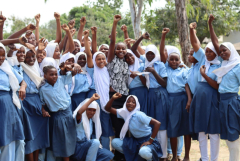In the coastal region of Kwale County, Kenya, a bold initiative is redefining how communities support their girls. Born from the challenges of teenage pregnancy, school dropouts, and gender-based violence, the G for Girls Initiative is leading a local movement of hope, resilience, and transformation.

A Community of Change: How Local Fundraising is Empowering Girls in Kenya
By: Kenya Community Development Foundation (KCDF)
In Kwale County, a women-led initiative is proving that sustainable change starts from within by mobilizing local resources, mentoring girls, and building stronger communities.
In the coastal region of Kwale County, Kenya, a women-led movement is transforming the way communities support girls. Confronting challenges like teenage pregnancy, school dropouts, and gender-based violence, the G for Girls Initiative is harnessing the power of local fundraising to build a future rooted in hope, resilience, and collective action. With support from the Kenya Community Development Foundation (KCDF) and training from Change the Game Academy, this organization is proving that sustainable change doesn’t always come from outside: it starts within, when local voices are heard, and resources are mobilized from the ground up.
A New Approach: From Service Delivery to Community Ownership
In October 2021, the G for Girls Initiative was created to create a safe space for mentorship, education, and leadership development for girls and to awaken community-driven changemakers.
Before founding G for Girls, Priscah Mongera worked as Programs Manager at Girls on Fire, where she first encountered KCDF. While applying for a matching grant, she was introduced to Change the Game Academy’s training. “The Mobilising Support training was an eye-opener,” Priscah recalls. “It helped me understand that our role isn't just to deliver services, but to empower communities to speak up and engage with government structures.”
The training planted a seed: she became curious about how local fundraising could change not just her organization, but the entire ecosystem around it. She dove into the online fundraising course, learning how to craft compelling pitches, prepare budgets, write effective proposals, and develop one-pagers to communicate the organization’s mission. More importantly, the experience shifted her mindset, showing that resource mobilization is about much more than money: It’s about building partnerships, sharing expertise, and engaging individuals, local government, and the private sector to contribute in multiple ways.
Impact in Action: Education, Enterprise, and Empowerment
To tackle school dropouts and early pregnancy, G for Girls launched the "Adopt A Girl": project linking girls in need with individual sponsors. Each year of secondary school costs around 45,000 Kenyan shillings (about $350 dollars). While sponsorships may not cover the full cost upfront, donors commit to regular contributions. “So far, we’ve raised 135,000 shillings (about $1.042 dollars) to support three girls in their first year,” says Priscah. “Our goal is to raise 540,000 shillings (about $ 4.173 dollars) over four years to support four girls through all of secondary school.”
In addition, the initiative created the GGI Merchandise Shop, selling branded items like T-shirts and thermal mugs. This small enterprise has raised 60,000 shillings (about $ 463 dollars) to support their programs. They also saved 120,000 shillings (about 927 dollars) in the past year by negotiating with local chiefs and village leaders to use public spaces rent-free for trainings and community dialogues; another direct result of the community engagement strategies learned through the trainning.
One of the most impactful contributions came from the community itself: a plot of land valued at 300,000 shillings (about $ 2318 dollars), donated for the creation of a future Community Resource Centre. While construction is still in the planning phase, they currently use a makeshift space to host Saturday library sessions for 50 to 70 children. Donated books from across Kenya, valued at 200,000 shillings (about $ 1545 dollars), fill their shelves.
Working Smarter, Together
Priscah emphasizes the importance of strategic partnerships. In one child protection initiative, G for Girls collaborated with Kids Care and the county's Child Protection Department to share costs and resources. By aligning transport, accommodation, and facilitation roles among partners, they saved nearly 1,000,000 shillings (about $ 7726 dollars); a saving that allowed them to sustain activities even after funding ended, and secure an advance from a donor to bridge the gap.
In another innovative strategy, Priscah began allocating 10% of any personal travel reimbursement she received while attending partner meetings back into the organization; a small but symbolic gesture that inspired others and raised 150,000 shillings (about $ 1159 dollars) for G for Girls.
Despite these successes, the journey hasn’t been without challenges. One major hurdle: internal alignment around the importance of local fundraising. “With only two of us trained, it was overwhelming,” says Priscah. “Now we’re working to involve 90% of our team in understanding and implementing fundraising strategies.”
They’ve created a new organizational structure with clear fundraising roles and responsibilities and emphasized the importance of involving both senior management and frontline staff in training sessions to ensure long-term buy-in.
For Priscah, the journey with Change the Game Academy has been transformative. “I’m so grateful for the opportunity. It’s not just about raising money; it’s about learning how to truly empower others. These tools have helped me become a better leader and equipped our organization to make a deeper impact.”
As G for Girls Initiative looks to the future, their vision is clear: a community where girls lead, thrive, and transform the world around them and where the resources to do so come not from handouts, but from the hands and hearts of the community itself.
“We’re not just changing girls’ lives,” Priscah concludes. “We’re changing the way communities see their own power.”